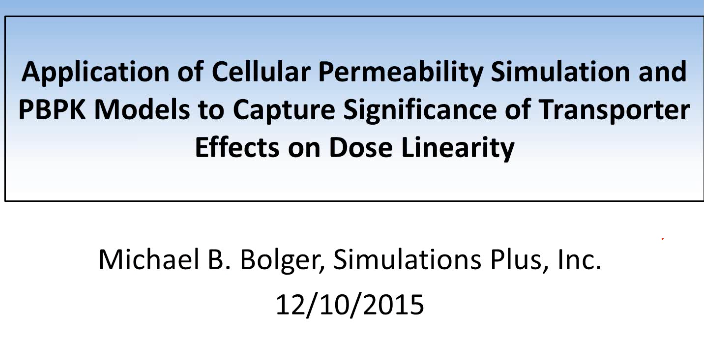In the present study, hydrophilic and hydrophobic grades of Aerosil® were employed as adsorbents to develop a solid self-nanoemulsifying drug delivery system (S-SNEDDS) of loratadine and were...

A canine biorelevant dissolution method for predicting in vivo performance of orally administered sustained release matrix tablets
Preclinical species are a crucial component of drug development, but critical differences in physiology and anatomy need to be taken into account when attempting to extrapolate to humans or between species.

The potential of immobilized artificial membrane chromatography to predict human oral absorption
The potential of immobilized artificial membrane (IAM) chromatography to estimate human oral absorption (%HOA) was investigated.

Elucidating Differences in the Hepatotoxic Potential of Tolcapone and Entacapone With DILIsym(®), a Mechanistic Model of Drug-Induced Liver Injury.
Tolcapone and entacapone are catechol-O-methyltransferase (COMT) inhibitors developed as adjunct therapies for treating Parkinson's disease.

Biomarker exposure-response relationships as the basis for rational dose selection: Lessons from a simulation exercise using a selective COX-2 inhibitor
An exposure-response model was used to characterize the pharmacokinetic-pharmacodynamic relationship of GW406381, a COX-2 inhibitor, based on data from ex vivo...

Development of a unified dissolution and precipitation model and its use for the prediction of oral drug absorption
Drug absorption is a complex process involving dissolution and precipitation, along with other kinetic processes.

Application of Cellular Permeability Simulation and PBPK Models to Capture
In this GastroPlus™ User Group webinar, we will discuss the validation of passive permeability estimates in MembranePlus™ based on molecular structure alone for a library of diverse compounds and how...

Mitigation of Adverse Clinical Events of a Narrow Target Therapeutic Index Compound through Modified Release Formulation Design: An In Vitro, In Vivo, In Silico, and Clinical Pharmacokinetic Analysis
BMS-914392 is a tricyclic pyranoquinoline BCS class 2 weak base that demonstrates high solubility in low pH environments. Initial clinical studies indicated that rapid release of high dose BMS-914392 led to...

Analysis of Intra- and Intersubject Variability in Oral Drug Absorption in Human Bioequivalence Studies of 113 Generic Products
In this study, the data of 113 human bioequivalence (BE) studies of immediate release (IR) formulations of 74 active pharmaceutical ingredients (APIs) conducted at Sawai Pharmaceutical Co., Ltd., was...
![Radiosynthesis and evaluation of N-(3,4-dimethylisoxazol-5-yl)piperazine-4-[4-(4-fluorophenyl)thiazol-2-yl]-1-[11C]carboxamide for in vivo positron emission tomography imaging of fatty acid amide hydrolase in brain](https://www.simulations-plus.com/wp-content/themes/simulations-plus/library/dist/img/default_square-large.jpg)
Radiosynthesis and evaluation of N-(3,4-dimethylisoxazol-5-yl)piperazine-4-[4-(4-fluorophenyl)thiazol-2-yl]-1-[11C]carboxamide for in vivo positron emission tomography imaging of fatty acid amide hydrolase in brain
We developed a novel positron emission tomography (PET) radiotracer N-(3,4-dimethylisoxazol-5-yl)piperazine-4-[4-(4-fluorophenyl)thiazol-2-yl]-1-[11C]carboxamide ([11C]DPFC, [11C]1) for in vivo...

2015 White Paper on recent issues in bioanalysis: focus on new technologies and biomarkers (Part 2 – hybrid LBA/LCMS and input from regulatory agencies)
The 2015 9th Workshop on Recent Issues in Bioanalysis (9th WRIB) took place in Miami, Florida with participation of over 600 professionals from pharmaceutical and biopharmaceutical companies, biotechnology companies, contract research organizations and regulatory agencies worldwide
![Identification of a major radiometabolite of [11C]PBB3](https://www.simulations-plus.com/wp-content/themes/simulations-plus/library/dist/img/default_square-large.jpg)
Identification of a major radiometabolite of [11C]PBB3
[11C]PBB3 is a clinically used positron emission tomography (PET) probe for in vivo imaging of tau pathology in the brain. Our previous study showed that [11C]PBB3 was rapidly decomposed to...

Effect of SI-591, a new class of cathepsin K inhibitor with peptidomimetic structure, on bone metabolism in vitro and in vivo
SI-591[N-[1-[[[(1S)-3-[[(3S)-hexahydro-2-oxo-1H-azepin-3-yl]amino]-1-(1-methylethyl)-2,3-dioxopropyl]amino]carbonyl]cyclohexyl]-2-furancarboxamide] is an orally bioavailable compound that was synthesized as...

Preclinical pharmacokinetics of TPN729MA, a novel PDE5 inhibitor, and prediction of its human pharmacokinetics using a PBPK model
TPN729MA is a novel selective PDE5 inhibitor currently under clinical development in China for the treatment of erectile dysfunction. In this study we characterized its preclinical pharmacokinetics (PK) and predict its human PK...

Homology Modeling, Molecular Dynamic Simulation and In Silico Screening of Activator for the Intensification of Human Sirtuin Type 1 (SIRT1) By Novel 1, 3, 4-Thiadiazole Derivatives-A Potential Antiaging Approach
Sirtuin type-1(SIRT1) is a regulator of various biosynthetic pathways via activation of peroxisome proliferator-activated receptor-γ and interacting with adenosine-mono-phosphate kinase.

In vitro-in vivo correlation of parenteral risperidone polymeric microspheres
The objective of the present study was to determine whether an in vitro-in vivo correlation (IVIVC) can be established for polymeric microspheres that are equivalent in formulation composition but...

Simulations Plus to Present at Two Upcoming Investor Conferences
Management to Present at LD Micro Conference in Los Angeles on December 2, and to Attend One-on-One Meetings at the Benchmark MicroCap Discovery Conference in Chicago on December 10

Physicochemical Understanding of Solubility and Supersaturation for the Enhancement of the Oral Absorbability of Poorly Soluble Drugs
Many new chemical entities are developed as oral solid form drugs such as tablets and capsules due to their patient-friendliness.
